Why Your IT Department Should Consider Freshservice: A Comprehensive Review. In today’s fast-paced business environment, efficient IT service management is no longer optional — it’s essential. As organizations continue to digitize operations, the demand for streamlined IT services has never been higher. Enter Freshservice, a cloud-based ITSM platform that’s gaining attention for its AI-powered approach and user-friendly interface. But is it the right fit for your organization? Let’s dive deep into what Freshservice offers and how it stacks up against competitors in 2025.
The Evolution of ITSM and Where Freshservice Fits In
The ITSM landscape has transformed dramatically over the past decade. What began as simple ticketing systems has evolved into comprehensive platforms that manage entire IT ecosystems. Freshservice, developed by Freshworks Inc., entered this evolving market with a clear mission: simplify IT operations without sacrificing functionality.
Unlike legacy systems that require extensive coding knowledge and lengthy implementation periods, Freshservice was designed with accessibility in mind. This philosophy aligns perfectly with the current trend toward democratizing technology across organizations, allowing non-technical staff to participate in service management processes.
According to recent industry reports, companies that implement modern ITSM solutions like Freshservice see up to 30% reduction in IT resolution times and significant improvements in employee satisfaction scores. These efficiency gains have become particularly crucial as remote and hybrid work environments continue to dominate the corporate landscape.

Key Features That Set Freshservice Apart
AI-Powered Service Operations
At the heart of Freshservice’s offering is Freddy AI, an intelligent assistant that transforms how IT teams operate. Freddy doesn’t just automate responses to common queries — it learns from interactions, becoming more effective over time.
When you implement Freshservice, Freddy can:
- Automatically categorize and route incoming tickets
- Suggest solutions based on historical data
- Identify potential service disruptions before they impact users
- Provide actionable insights on service performance
This AI integration is particularly valuable for organizations looking to scale their IT operations without proportionally increasing headcount. As one IT director at a mid-sized financial services firm told TechCrunch, “Freddy handles about 40% of our routine queries now, letting our specialists focus on complex issues that actually require human expertise.”

No-Code Workflow Automation
One of Freshservice’s most appealing features is its approach to automation. You don’t need to be a developer to create sophisticated workflows — the platform offers intuitive, drag-and-drop tools that empower IT teams to automate repetitive processes.
This capability extends beyond basic ticket routing. You can automate:
- Asset lifecycle management
- Service request approvals
- Change management procedures
- Scheduled maintenance notifications
The impact of these automations compounds over time. Organizations using Freshservice report saving an average of 15–20 hours per IT staff member monthly on routine tasks, according to recent user surveys published on Venturebeat.
Unified Omnichannel Support
In 2025, your employees expect to receive IT support through their preferred communication channels. Freshservice addresses this expectation by consolidating multiple channels into a single interface.
When you implement Freshservice, your team can manage requests coming from:
- Web portal
- Mobile app
- Microsoft Teams
- Slack
- Walk-up service desks
This omnichannel approach ensures that no request falls through the cracks while giving employees flexibility in how they communicate with IT. The platform’s ability to maintain context across channels means that an issue initiated via chat can seamlessly transition to a formal ticket without losing information.

Comprehensive Asset Management
Freshservice’s asset management capabilities provide real-time visibility into your organization’s hardware, software, and SaaS investments. The platform’s auto-updating CMDB (Configuration Management Database) tracks relationships between assets and services, helping you understand the impact of changes or outages.
With Freshservice, you can:
- Track asset lifecycles from procurement to retirement
- Monitor software licenses and compliance
- Identify underutilized resources
- Plan for hardware refreshes and upgrades
This visibility is increasingly important as organizations manage hybrid environments with both on-premises and cloud assets. According to Gizmodo’s recent analysis of ITSM trends, comprehensive asset management can reduce IT spending by up to a quarter by eliminating redundant purchases and optimizing existing resources.
Integration Capabilities: Building Your IT Ecosystem
No modern ITSM solution exists in isolation, and Freshservice recognizes this reality with robust integration capabilities. The platform connects seamlessly with tools your team already uses, creating a cohesive IT ecosystem.
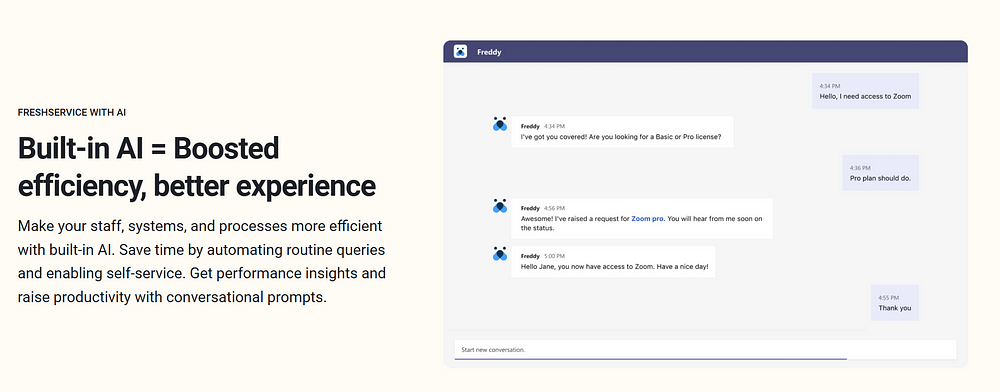
Microsoft Teams Integration
With remote work remaining a permanent fixture in many organizations, the integration between Freshservice and Microsoft Teams has become increasingly valuable. This connection allows your team to:
- Create and update tickets without leaving Teams
- Receive automated alerts about critical incidents
- Access customer details during support conversations
- Automate workflows between Teams and Freshservice
For organizations heavily invested in the Microsoft ecosystem, this integration streamlines communication and eliminates the need to switch between applications.
AWS and Cloud Monitoring
As more organizations migrate critical infrastructure to the cloud, Freshservice’s integration with AWS becomes a significant advantage. The platform can automatically import virtual assets into the CMDB and associate them with tickets, problems, and changes.
This integration provides several benefits:
- Unified view of both physical and virtual assets
- Automated incident creation based on AWS alerts
- Simplified change management for cloud resources
- Better visibility into cloud spending and utilization
According to recent coverage in Lifehacker, organizations that connect their cloud infrastructure with their ITSM solution experience 45% faster resolution times for cloud-related incidents.
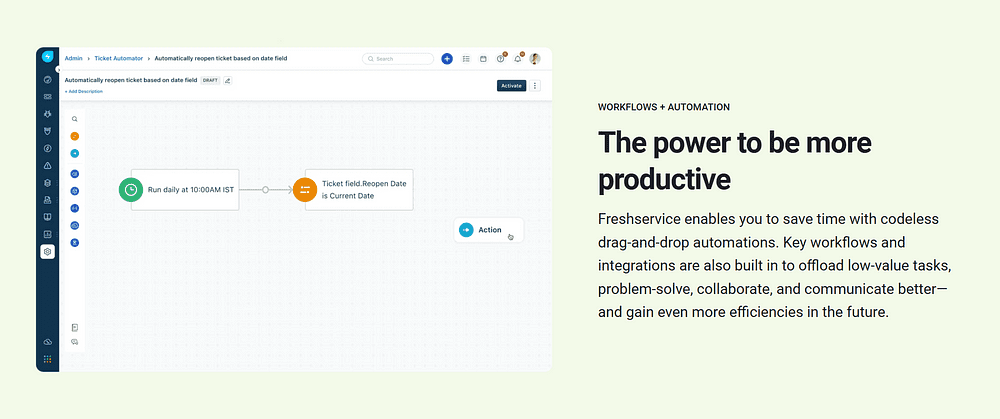
Additional Key Integrations
Beyond Teams and AWS, Freshservice offers integrations with dozens of other popular tools, including:
- Slack for team communications
- Zoom for remote troubleshooting
- Google Workspace for user management
- Jira for developer workflows
- Device42 for enhanced CMDB capabilities
This extensive integration network ensures that Freshservice can adapt to your existing toolset rather than forcing you to conform to its limitations.
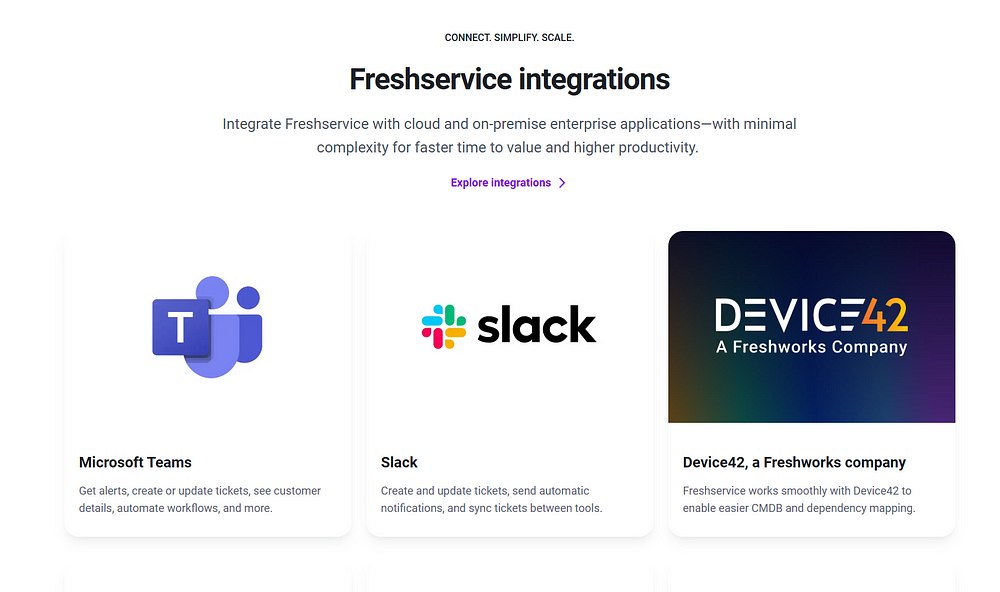
How Freshservice Compares to Leading Competitors
The ITSM market in 2025 features several strong contenders. Understanding how Freshservice stacks up against its primary competitors can help you make an informed decision.
Freshservice vs. ServiceNow
ServiceNow remains the enterprise leader, particularly for organizations with complex requirements and large IT departments. However, the gap between ServiceNow and Freshservice has narrowed significantly in recent years.
Where ServiceNow excels:
- Enterprise-scale customization
- Extensive module ecosystem
- Advanced workflow capabilities
Where Freshservice has an edge:
- Faster implementation (weeks vs. months)
- Lower total cost of ownership
- More intuitive user interface
- Less technical expertise required
According to a recent comparison on Geekwire, organizations with fewer than 5,000 employees often find Freshservice provides 80% of ServiceNow’s capabilities at roughly half the cost.
Freshservice vs. Jira Service Management
Atlassian’s Jira Service Management has gained traction, particularly among organizations already using Jira for development. The platform offers solid ITSM capabilities with natural integration into the Atlassian ecosystem.
Where Jira Service Management excels:
- Seamless integration with development workflows
- Strong project management capabilities
- Robust knowledge base features
Where Freshservice has an advantage:
- More comprehensive asset management
- Advanced AI capabilities
- Broader third-party integrations
- More intuitive service catalog
For organizations that prioritize alignment between IT and development teams, the choice often comes down to whether they’re already invested in the Atlassian ecosystem.
Freshservice vs. Zendesk
While primarily known for customer service, Zendesk has expanded its IT service management capabilities in recent years. It offers a familiar interface for organizations already using Zendesk for external support.
Where Zendesk excels:
- Unified external and internal support
- Strong knowledge management
- Extensive marketplace of apps
Where Freshservice pulls ahead:
- Purpose-built for ITSM (not adapted from customer service)
- More robust change management
- Superior CMDB and asset management
- More extensive ITIL alignment
Recent analysis from TechSpot suggests that organizations looking for a dedicated ITSM solution typically favor Freshservice, while those seeking to unify customer and employee support lean toward Zendesk.
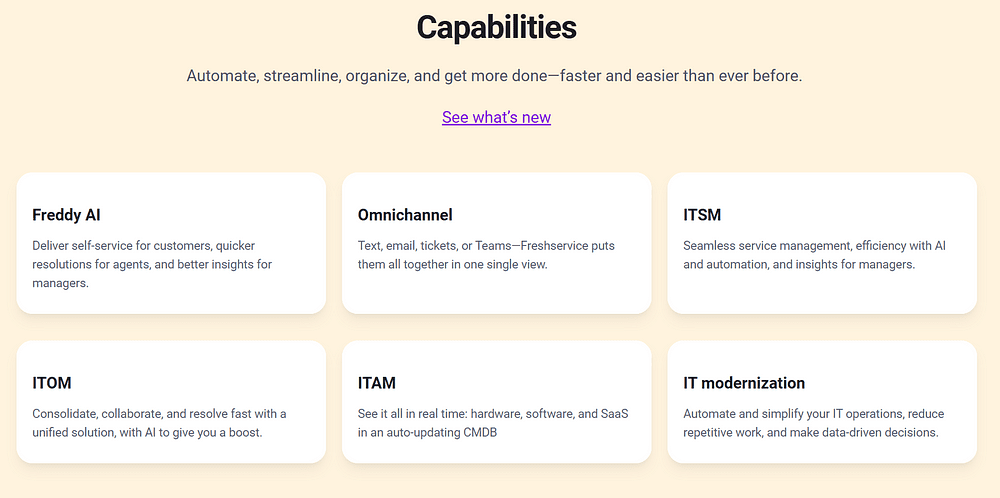
Implementation: Getting Started with Freshservice
One of Freshservice’s key advantages is its relatively straightforward implementation process. Unlike enterprise ITSM solutions that can take 6–12 months to fully deploy, Freshservice implementations typically range from 2 weeks to 3 months, depending on organizational complexity.
Key Implementation Steps
- Discovery and Planning: Define your service management objectives, identify stakeholders, and plan your implementation approach.
- Configuration: Set up your instance with service catalogs, workflows, SLAs, and user roles. Freshservice provides templates based on industry best practices to accelerate this process.
- Integration: Connect Freshservice to your existing tools and systems, including email, directory services, and collaboration platforms.
- Data Migration: Import existing tickets, knowledge base articles, and asset information from legacy systems.
- Testing and Training: Validate configurations and train both IT staff and end-users on the new platform.
- Go-Live and Optimization: Launch the platform and continue refining based on user feedback and changing requirements.
Freshservice offers implementation services for organizations that prefer guided assistance, while self-implementation resources are available for teams that prefer a DIY approach.
ROI and Business Impact: Making the Case for Freshservice
Implementing a new ITSM solution represents a significant investment, making ROI considerations crucial. Based on customer case studies and industry analyses from Mashable and Venturebeat, organizations typically see returns in several key areas:
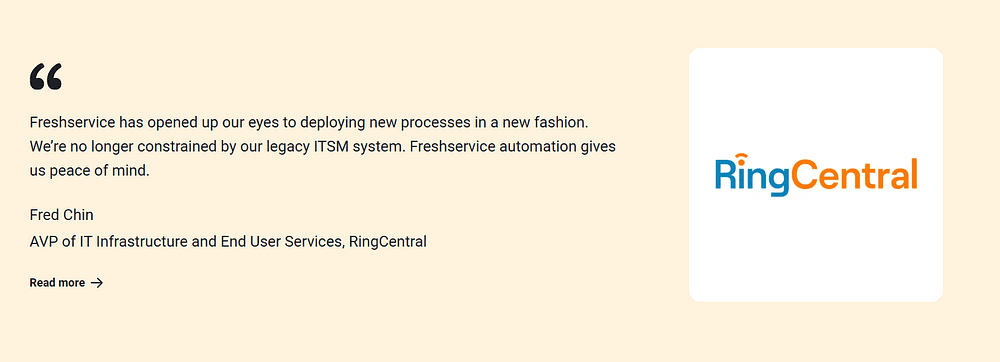
Quantifiable Benefits
- Reduced Resolution Times: Organizations report 30–50% reductions in mean time to resolution after implementing Freshservice.
- Increased Self-Service: The intuitive service portal and AI-powered knowledge base typically increase self-service resolution rates by 35–60%.
- Improved First-Contact Resolution: Teams using Freshservice see first-contact resolution rates improve by 20–30% on average.
- Reduced Administrative Overhead: Automation and streamlined workflows reduce administrative time by 25–40%.
- Asset Utilization: Improved visibility into IT assets typically results in 15–25% cost savings through optimized purchasing and lifecycle management.
Qualitative Improvements
Beyond the numbers, organizations implementing Freshservice report:
- Higher employee satisfaction with IT services
- Better alignment between IT and business objectives
- Improved compliance with internal and external regulations
- Enhanced ability to support remote and hybrid work models
- More proactive service delivery rather than reactive support
According to a recent analysis in TechCrunch, the average breakeven point for a Freshservice implementation occurs between 6–9 months, with ROI increasing substantially in subsequent years as automation and self-service capabilities mature.
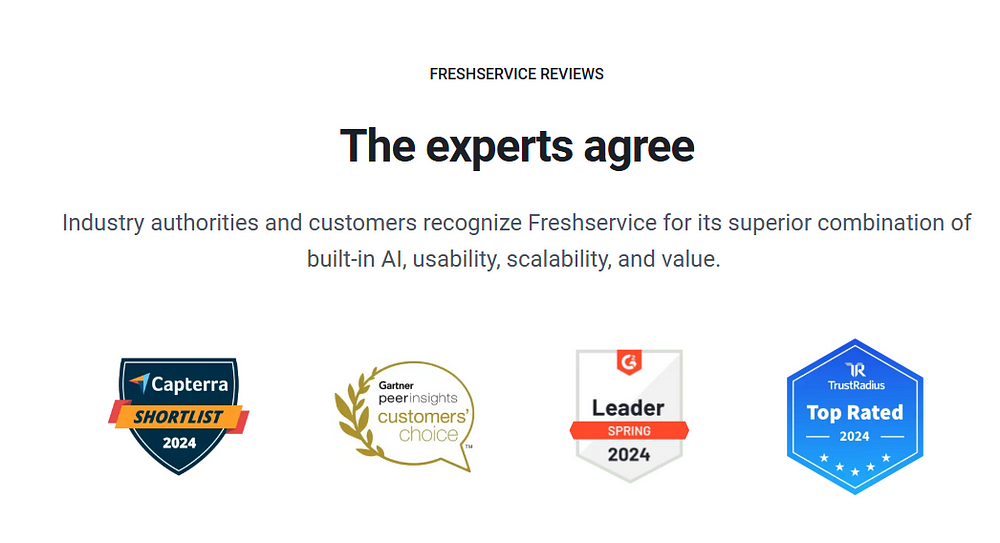
Future-Proofing Your ITSM: Freshservice’s Roadmap
When selecting an ITSM solution, considering the vendor’s future direction is as important as evaluating current capabilities. Freshservice has announced several upcoming enhancements that align with emerging IT trends:
Enhanced AI Capabilities
Building on Freddy AI’s foundation, Freshservice is expanding its artificial intelligence capabilities to include:
- Predictive incident management
- Automated root cause analysis
- Natural language processing for ticket classification
- AI-driven resource allocation recommendations
These enhancements promise to further reduce manual effort while improving service quality.
Expanded Automation
Future releases will include more sophisticated automation capabilities:
- Cross-platform workflow orchestration
- Condition-based automation triggers
- Automated compliance verification
- User-specific automation rules
These features will enable even non-technical users to create powerful automations that span multiple systems and processes.
Advanced Analytics and Reporting
Upcoming analytics enhancements will provide:
- Customizable executive dashboards
- Predictive service metrics
- Resource utilization forecasting
- Business impact analysis
These capabilities will help IT leaders better communicate value and make data-driven decisions about resource allocation.
Is Freshservice Right for You? Making the Decision
With a clearer understanding of what Freshservice offers, how do you determine if it’s the right solution for your organization? Consider these key factors:
Ideal Use Cases
Freshservice typically works best for:
- Mid-sized organizations (250–5,000 employees)
- Companies looking to modernize legacy ITSM solutions
- Organizations with limited IT resources seeking automation
- Businesses prioritizing rapid implementation and ease of use
- Companies wanting to align with ITIL practices without excessive complexity
Scenarios Where Alternatives Might Be Better
You might consider alternatives if:
- You require extensive customization at the code level
- Your organization exceeds 10,000 employees with complex IT structures
- You need specialized modules not available in Freshservice
- Your primary goal is unifying customer and employee support (Zendesk might be better)
- You’re deeply invested in the Atlassian ecosystem (Jira Service Management could be preferable)
Taking the Next Steps
If Freshservice seems like a potential fit for your organization, consider these next actions:
- Request a Personalized Demo: See how Freshservice would work with your specific requirements and existing tools.
- Start a Free Trial: Freshservice offers a 21-day trial that allows you to explore the platform’s capabilities in your own environment.
- Speak with Similar Organizations: Connect with peers in your industry who have implemented Freshservice to learn from their experiences.
- Develop an Implementation Plan: Define your objectives, timeline, and resource requirements for a potential implementation.
- Calculate Potential ROI: Use Freshservice’s ROI calculator to estimate the financial impact on your organization.
Modern IT service management is no longer about simply tracking tickets — it’s about creating seamless digital experiences that enable your entire organization to work more effectively. With its blend of AI-powered automation, intuitive interfaces, and comprehensive capabilities, Freshservice offers a compelling option for organizations looking to transform their IT operations without unnecessary complexity.
As workplace technology continues to evolve, the platforms that manage it must evolve as well. By selecting an ITSM solution that emphasizes both current functionality and future innovation, you position your organization to thrive in an increasingly digital business landscape.


